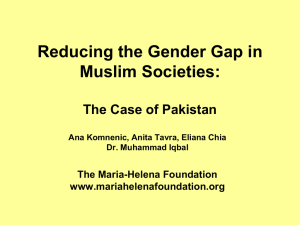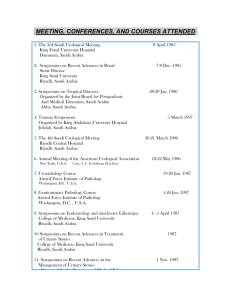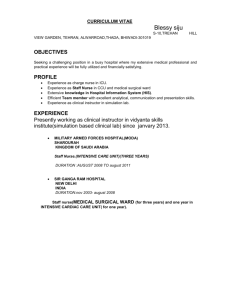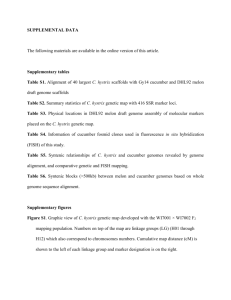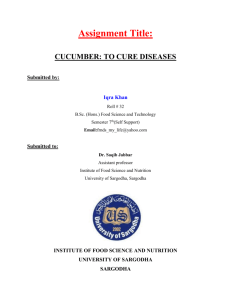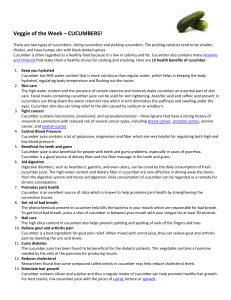Personal Information
advertisement
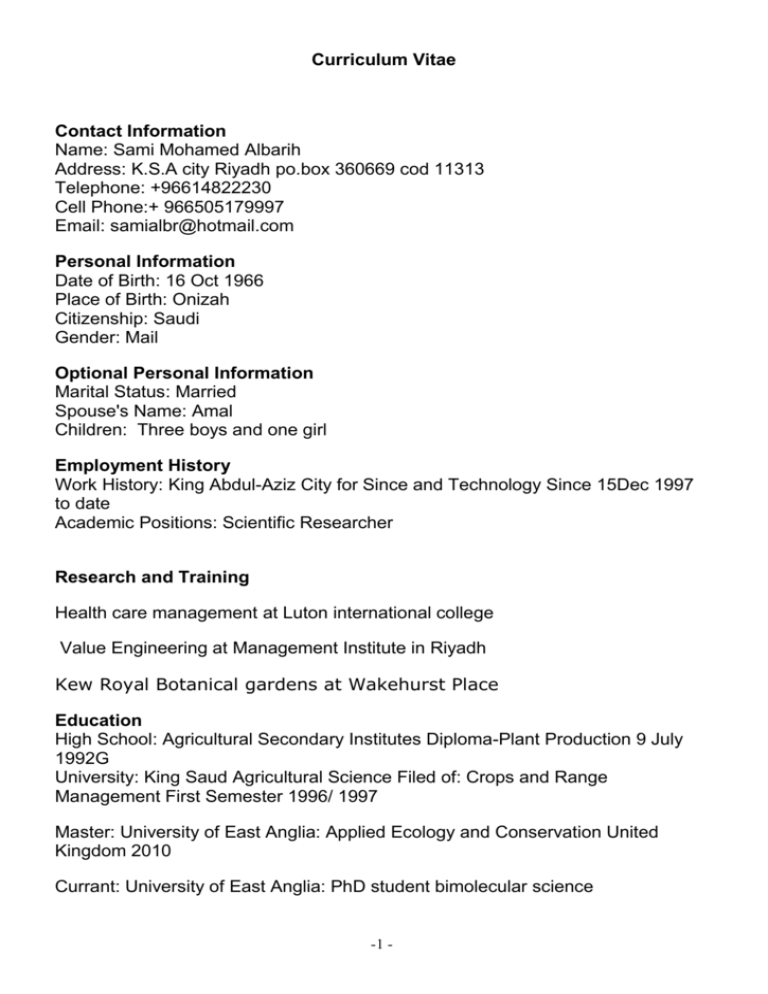
Curriculum Vitae Contact Information Name: Sami Mohamed Albarih Address: K.S.A city Riyadh po.box 360669 cod 11313 Telephone: +96614822230 Cell Phone:+ 966505179997 Email: samialbr@hotmail.com Personal Information Date of Birth: 16 Oct 1966 Place of Birth: Onizah Citizenship: Saudi Gender: Mail Optional Personal Information Marital Status: Married Spouse's Name: Amal Children: Three boys and one girl Employment History Work History: King Abdul-Aziz City for Since and Technology Since 15Dec 1997 to date Academic Positions: Scientific Researcher Research and Training Health care management at Luton international college Value Engineering at Management Institute in Riyadh Kew Royal Botanical gardens at Wakehurst Place Education High School: Agricultural Secondary Institutes Diploma-Plant Production 9 July 1992G University: King Saud Agricultural Science Filed of: Crops and Range Management First Semester 1996/ 1997 Master: University of East Anglia: Applied Ecology and Conservation United Kingdom 2010 Currant: University of East Anglia: PhD student bimolecular science -1 - Professional Qualifications Computer Skills o o o o o o o Word Processing Graphics Multi-media Internet Email Spreadsheets Databases Publications Research Done at Al-Muzahmiyah Research Station, King Abdulaziz City for Science and Technology (KACST), Riyadh. (Supervised By Sami Muhammad Al-Barih) Effect of Varying of Nitrogen Rate in the Feeding Solution on Growth and Yield of Drip-Fertigated Greenhouse-Grown Cucumber during Summer Cropping in Riyadh. (Technical Report NRERI, KACST) By Ali A. Al-Jalaoud, Sami M. Al-Barih and Catalino T. Ongkingco Abstract: This study was designed to determine the effects of different nitrogen concentrations in the feeding solution on drip Fertigated cucumber under greenhouse conditions. Treatments varied depending on growth stages, ranging from 60-120 ppm, 80-14- ppm, 100-160 ppm and 120-180 ppm as the highest level. Growth and field components revealed the followings: 1): Varying nitrogen concentration did not significantly influenced floral emergence and blooming, 2): Although plants were taller or tallest at higher N-concentration compared to control (lowest concentration), differences were not significant, 3): Treatments that received moderate concentration (100160 ppm) gave the highest total fruit weights and tons per hectare yield of 49.19 compared ot control with only 43.42 tons/ha. The highest N-concentration got 46.43 tons/ha. Or a drop of 0.06 kg fruit weights and 1.26 tons/ha. Yield and 4): this experiment recorded 1967 m3 water applied per hectare based on 1.00-1.75 liters/plant/day application in the duration of trial for 65 days. Water Requirements of Drip Fertigated Greenhouse Grown Cucumber and Tomato during Winter and Summer Cropping By Ali A. Al-Jalaoud, Sami M. Al-Barih and Catalino T. Ongkingco, W. Al-Bashir, A. Al-Askar, S. AlAswed and S. karimullah (Technical Report No: 252-22-AL; 2001) Abstract: Application of precise amount of irrigation water to different crops in different growing seasons at various crop growth stages and the soil type is very important in an arid environment. Water deficiency causes water stress to plants and results in low yield. Whereas, high amount of irrigation water causes leaching losses of plant nutrients beyond root zone. A series of experiments were conducted during 19960=97 on cucumber and tomato crops in greenhouse under controlled environment using Complete Randomized Block Design. A considerable saving was observed in drip irrigated cucumber by reducing the application of irrigation water up to 40 % i.e. from 5000 m3 ha.-1 (2.5 liters /plant/day) to around 2000-3000 m3 ha.-1 (1.3-1.5 liters /plant/day) during winter and summer seasons. The low rate of water application to cucumber crop sustained production and increased -2 - water use efficiency without significant decrease in growth and yield components. Similarly, for tomato crop, enormous saving were recorded by reducing the standard water application by 30 % without significant yield losses. The water use efficiency also increased by 4-8 kg fresh tomato m-3 of water . However, water application less than 7000 m3 /ha showed a decline in yield to the level of 16-21 tons/a. without significant increase in water use efficiency. Effect of water Quality on Drip-Fertigated Greenhouse Cucumber and Tomato during Winter and Summer Cropping in Riyadh area. By Ali A. Al-Jalaoud, Sami M. Al-Barih and Catalino T. Ongkingco, W. Al-Bashir, A. Al-Askar, S. AlAswed and S. karimullah (Technical Report No: 252-22-AL; 1998) Abstract: These studies conducted in four locations were designed to determine the feasibility of fertigating cucumber and tomato using raw or fresh water or both in the following proportions: 40 % raw and 60 % fresh, and 25 % raw and 75 % fresh corresponding to 1000 and 1200 ppm salt concentration (TDS), respectively. Raw water contained approximately 1400 ppm salt while fresh or processed water from treatment plant at 800 ppm total dissolved solids (TDS) or EC of about 1.25 dS m-1. The results of these studies generated from different cropping seasons revealed no significant differences among treatments in terms of growth and yield of drip fertigated greenhouse cucumber and tomato under sandy soil conditions. Yield data, hence, indicate that feeding solutions in fetigation containing up to 1400 ppm salt concentration could still sustain acceptable growth and production efficiency without considerable decrease in growth and yield components of cucumber and tomato. The Profitability of Drip Fertigated Greenhouse Vegetables in Saudi Arabia Using Different Water Qualities. By Ali A. Al-Jalaoud, Sami M. Al-Barih and Catalino T. Ongkingco, W. Al-Bashir, A. Al-Askar, S. AlAswed and S. karimullah (Technical Report No: 251-22-AL; 2001) Agriculture is a promising sector in Saudi Arabia, yet it is a challenging practice. It is a promising sector because agriculture has the potential to diversify the national economy and to fulfill self-sufficiency of the vital food needs. It is, however, a challenging practice because Saudi Arabia is an arid country where water is scarce and the climate conditions are harsh. Due to the capability of higher productivity and efficient use of irrigation water , greenhouse use in agriculture is one of the favorable investments in Saudi Arabia. The main goal of this study was to determine the profitability of drip fertigated greenhouse vegetables in Saudi Arabia using different water qualities. Cucumber and tomato crops were grown in different seasons using four different water qualities ranging between 800-1400 ppm total salt concentration. All water treatments showed positive net return, yet the use of freshwater with 1400 ppm and 2.2 dS m-1 EC would generate highest net return than all other treatments, hence it would be a favorable decision in agriculture sector of Saudi Arabia to use such fresh waters for expansion of greenhouse crop production -3 - Albarih,S.M.(2010). Ex-situ Conservation of rare and indigenous crops growing in Al-Qassim region, Saudi Arabia. MSc. Dissertation, University of East Anglia, UK. Summary The loss of the genetic diversity of some of the world's crops has accelerated in recent decades, with many crops becoming increasingly susceptible to diseases, pests, and environmental stresses. Over the years people around the world had developed hundreds of crop plants through continuous selection and breeding. Extensive and intensive breeding programmes especially during the latter half of 20th century have, eventually, resulted in replacing many of the age-old cultivars with high yielding varieties, which has often created problems to small-scale traditional producers, whose working resources were low inputs and marginal lands. The preservation of indigenous agriculture along with the genetic diversity found in those areas associated with agricultural origins and development, such as the areas in the southwestern Arabian Peninsula and the northeast Africa, is a priority. The Al-Qassim region of the Arabian Peninsula is widely regarded as a centre of origin of cereals such as Wheat, Millet and Barley, where indigenous varieties are being cultivated. These varieties were collected systematically, according to the standard methods for preserving germplasms. Seeds were collected to represent the genetic diversity of each population. Herbarium voucher specimens were made of each for future reference. All samples were geo-referenced using GPS for future access to these farms. Soil samples from the root zone each population were analyzed for pH, Electrical conductivity, physical texture anions (Cl, SO4, NO3 and PO4) and cations (Na, K, Ca, and Mg and HCO3). Seeds were tested for germinability and viability (tetrazolium test) and their moisture contents determined. X- ray radiography was used to examine the internal structure and discriminate healthy seeds. Germination responses to external salinity, and constant and alternating temperatures were investigated. Finally, seeds were stored in the cold rooms of the gene bank at (MUZA), King Abdul-Aziz city for science and technology (KACST). Professional Memberships ISHS International Society for Horticultural Science British Ecological society Kew Royal Botanical gardens -4 -


